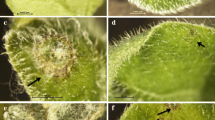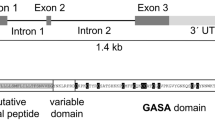Abstract
Key message
Over-expression of the potato Gibberellin Stimulated-Like 2 ( GSL2 ) gene in transgenic potato confers resistance to blackleg disease incited by Pectobacterium atrosepticum and confirms a role for GSL2 in plant defence.
Abstract
The Gibberellin Stimulated-Like 2 (GSL2) gene (also known as Snakin 2) encodes a cysteine-rich, low-molecular weight antimicrobial peptide produced in potato plants. This protein is thought to play important roles in the innate defence against invading microbes. Over-expression of the GSL2 gene in potato (cultivar Iwa) was achieved using Agrobacterium-mediated gene transfer of a plant expression vector with the potato GSL2 gene under the regulatory control elements of the potato light-inducible Lhca3 gene. The resulting plants were confirmed as being transgenic by PCR, and subsequently analysed for transcriptional expression of the Lhca3-GSL2-Lhca3 chimeric potato gene. Quantitative RT-PCR analysis demonstrated that the majority of the transgenic potato lines over-expressed the GSL2 gene at the mRNA level. Based on qRT-PCR results and evaluation of phenotypic appearance, eight lines were selected for further characterisation and evaluated in bioassays for resistance to Pectobacterium atrosepticum (formerly Erwinia carotovora subsp. atroseptica), the causal agent of blackleg in potato. Three independent pathogenicity bioassays showed that transgenic lines with significantly increased transcriptional expression of the GSL2 gene exhibit resistance to blackleg disease. This establishes a functional role for GSL2 in plant defence against pathogens in potato.






Similar content being viewed by others
References
Almasia NI, Bazzini AA, Hopp HE, Vazquez-Rovere C (2008) Overexpression of snakin-1 gene enhances resistance to Rhizoctonia solani and Erwinia carotovora in transgenic potato plants. Mol Plant Pathol 9:329–338
Aubert D, Chevillard M, Dorne AM, Arlaud G, Herzog M (1998) Expression patterns of GASA genes in Arabidopsis thaliana: the GASA4 gene is up-regulated by gibberellins in meristematic regions. Plant Mol Biol 36:871–883
Balaji V, Smart CD (2012) Over-expression of snakin-2 and extension-like protein genes restricts pathogen invasiveness and enhances tolerance to Clavibacter michiganensis subsp. michiganensis in transgenic tomato (Solanum lycopersicum). Transgenic Res 21:23–37
Balaji V, Sessa G, Smart CD (2011) Silencing of host basal defense response-related gene expression increases susceptibility of Nicotiana benthamiana to Clavibacter michiganensis subsp. michiganensis. Phytopathology 101:349–357
Barrell PJ, Conner AJ (2006) Minimal T-DNA vectors suitable for agricultural deployment of transgenic plants. Biotechniques 41:708–710
Barrell PJ, Conner AJ (2009) Expression of a chimeric magainin gene in potato confers improved resistance to the phytopathogen Erwinia carotovora. Open Plant Sci J 3:14–21
Barrell PJ, Meiyalaghan S, Jacobs JME, Conner AJ (2013) Applications of biotechnology and genomics in potato improvement. Plant Biotech J 11:907–920
Bell KS, Sebaihia M, Pritchard L, Holden MTG, Hyman LJ, Holeva MC, Thomson NR, Bentley SD, Churcher LJC, Mungall K, Atkin R, Bason N, Brooks K, Chillingworth T, Clark K, Doggett J, Fraser A, Hance Z, Hauser H, Jagels K, Moule S, Norbertczak H, Ormond D, Price C, Quail MA, Sanders M, Walker D, Whitehead S, Salmond GPC, Birch PRJ, Parkhill J, Toth IK (2004) Genome sequence of the enterobacterial phytopathogen Erwinia carotovora subspecies atroseptica and characterization of virulence factors. Proc Natl Acad Sci USA 101:11105–11110
Ben-Nissan G, Lee JY, Borohov A, Weiss D (2004) GIP, a Petunia hybrida GA-induced cysteine-rich protein: a possible role in shoot elongation and transition to flowering. Plant J 37:229–238
Bernatzky R, Tanksley SD (1986) Genetics of actin-related sequences in tomato. Theor Appl Genet 72:314–321
Berrocal-Lobo M, Segura A, Moreno M, Lopez G, Garcia-Olmedo F, Molina A (2002) Snakin-2, an antimicrobial peptide from potato whose gene is locally induced by wounding and responds to pathogen infection. Plant Physiol 128:951–961
Bindschedler LV, Whitelegge JP, Millar DJ, Bolwell GP (2006) A two component chitin-binding protein from French bean: association of a proline-rich protein with a cysteine-rich polypeptide. FEBS Lett 580:1541–1546
Conner AJ, Christey MC (1994) Plant breeding and seed marketing options for the introduction of transgenic insect-resistant crops. Biocontrol Sci Tech 4:463–473
Conner AJ, Jacobs JME (2000) Food risks from transgenic crops in perspective. Nutrition 16:709–711
Conner AJ, Williams MK, Abernethy DJ, Fletcher PJ, Genet RA (1994) Field testing of transgenic potatoes. N Z J Crop Hort Sci 22:361–371
Czajkowski R, Pérombelon MCM, van Veen JA, van der Wolf JM (2011) Control of blackleg and tuber soft rot of potato caused by Pectobacterium and Dickeya species. Plant Pathol 60:999–1013
de la Fuente JI, Amaya I, Castillejo C, Sanchez-Sevilla JF, Quesada MA, Botella MA, Valpuesta V (2006) The strawberry gene FaGAST affects plant growth through inhibition of cell elongation. J Exp Bot 57:2401–2411
Doyle JJ, Doyle JL (1990) Isolation of plant DNA from fresh tissue. Focus 12:13–15
Furukawa T, Sakaguchi N, Shimada H (2006) Two OsGASR genes, rice GAST homologue genes that are abundant in proliferating tissues, show different expression patterns in developing panicles. Genes Genet Syst 81:171–180
Hammami R, Ben Hamida J, Vergoten G, Fliss I (2009) PhytAMP: a database dedicated to antimicrobial plant peptides. Nucleic Acids Res 37:D963–D968
Hinton JCD, Pérombelon MCM, Salmond GPC (1985) Efficient transformation of Erwinia carotovora subsp. carotovora and E. carotovora subsp. atroseptica. J Bact 161:295–299
Höfgen R, Willmitzer L (1988) Storage of competent cells for Agrobacterium transformation. Nucleic Acids Res 16:9877
Hood EE, Gelvin SB, Melchers LS, Hoekema A (1993) New Agrobacterium helper plasmids for gene transfer to plants. Transgenic Res 2:208–218
Hyman LJ, Sullivan L, Toth IK, Pérombelon MCM (2001) Modified crystal violet pectate medium (CVP) based on a new polypectate source (Slendid) for the detection and isolation of soft rot erwinias. Potato Res 44:265–270
Kotilainen M, Helariutta Y, Mehto M, Pöllänen E, Albert VA, Elomaa P, Teeri T (1999) GEG participates in the regulation of cell and organ shape during corolla and carpel development in Gerbera hybrida. Plant Cell 11:1093–1104
Kovalskaya N, Hammond RW (2009) Expression and functional characterization of the plant antimicrobial snakin-1 and defensin recombinant proteins. Protein Expr Purif 63:12–17
López-Solanilla E, García-Olmedo F, Rodríguez-Palenzuela P (1998) Inactivation of the sapA to sapF locus of Erwinia chrysanthemi reveals a common features in plant and animal bacterial pathogenesis. Plant Cell 10:917–924
López-Solanilla E, González-Zorn B, Novella S, Vázquez-Boland JA, Rodríguez-Palenzuela P (2003) Susceptibility of Listeria monocytogenes to antimicrobial peptides. FEMS Microbiol Lett 226:101–105
Mao ZC, Zheng JY, Wang YS, Chen GH, Yang YH, Feng DX, Xie BY (2011) The new CaSn gene belonging to the snakin family induces resistance against root-knot nematode infection in pepper. Phytoparasitica 39:151–164
Meiyalaghan S, Jacobs JME, Butler RC, Wratten SD, Conner AJ (2006) Expression of cry1Ac9 and cry9Aa2 genes under a potato light-inducible Lhca3 promoter in transgenic potatoes for tuber moth resistance. Euphytica 147:297–309
Meiyalaghan S, Mohan S, Pringle JM, Baldwin SJ, Jacobs JME, Conner AJ (2009) Towards disease resistance in potatoes using intragenic approaches. Comm Appl Biol Sci 74:667–679
Nahirñak V, Almasia NI, Fernandez PV, Hopp HE, Estevez JM, Carrari F, Vazquez-Rovere C (2012) Potato Snakin-1 gene silencing affects cell division, primary metabolism and cell wall composition. Plant Physiol 158:252–263
Nap JP, van Spanje M, Dirkse WG, Baarda G, Mlynarova L, Loonen A, Grondhuis P, Stiekema WJ (1993) Activity of the promoter of the Lhca3.St.1 gene, encoding the potato apoprotein 2 of the light-harvesting complex of photosystem I, in transgenic potato and tobacco plants. Plant Mol Biol 23:605–612
Nicot N, Hausman JF, Hoffmann L, Evers D (2005) Housekeeping gene selection for real-time RT-PCR normalization in potato during biotic and abiotic stress. J Exp Bot 56:2907–2914
Pelegrini PB, del Sarto RP, Silva ON, Franco OL, Grossi-de-Sa MF (2011) Antibacterial peptides from plants: what they are and how they probably work. Biochem Res Int 250349:9. doi:10.1155/2011/250349
Roxrud I, Lid SE, Fletcher JC, Schmidt EDL, Opsahl-Sorteberg HG (2007) GASA4, one of the 14-member Arabidopsis GASA family of small polypeptides, regulates flowering and seed development. Plant Cell Physiol 48:471–483
Segura A, Moreno M, Madueño F, Molina A, Garcia-Olmedo F (1999) Snakin-1, a peptide from potato that is active against plant pathogens. Mol Plant-Microbe Interact 12:16–23
Toth IK, Mulholland V, Cooper V, Bentley S, Shih Y-L, Perombelon MCM, Salmond GPC (1997) Generalised transduction in the blackleg pathogen Erwinia carotovora subsp. atroseptica by bacteriophage φM1. Microbiology 143:2433–2438
Wang Z, Wang G (2004) APD: the antimicrobial peptide database. Nucleic Acids Res 32:D590–D592
Acknowledgments
We thank David Lewis, Ian King and Stuart Larsen for providing plant growth facilities, Ruth Butler for help with analysis of the qPCR data to determine the density of P. atrosepticum and Alasdair Noble for assistance with analysis of variance. This work was supported by AGMARDT Grant 20791 and Ministry of Business, Innovation and Employment (New Zealand) contract C02X0202 to The New Zealand Institute for Plant & Food Research Ltd.
Conflict of interest
The authors declare that they have no conflict of interest.
Ethical standards
The authors declare that the experiments comply with the laws of New Zealand.
Author information
Authors and Affiliations
Corresponding author
Additional information
Communicated by H. J. van Eck.
Rights and permissions
About this article
Cite this article
Mohan, S., Meiyalaghan, S., Latimer, J.M. et al. GSL2 over-expression confers resistance to Pectobacterium atrosepticum in potato. Theor Appl Genet 127, 677–689 (2014). https://doi.org/10.1007/s00122-013-2250-2
Received:
Accepted:
Published:
Issue Date:
DOI: https://doi.org/10.1007/s00122-013-2250-2




